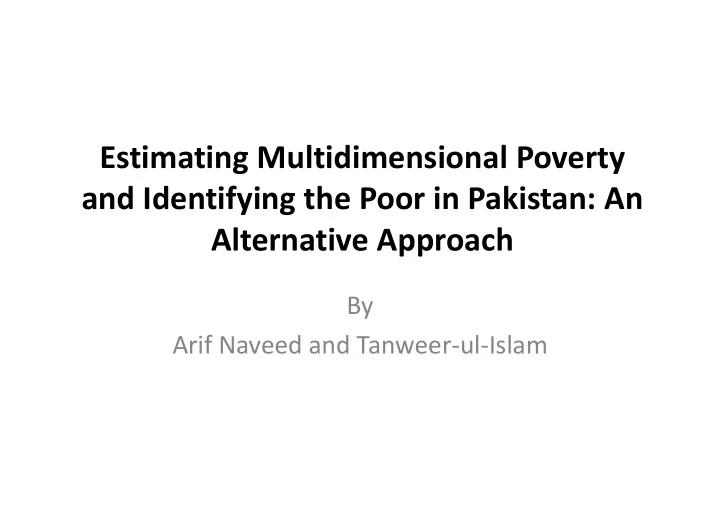

Estimating Multidimensional Poverty and Identifying the Poor in Pakistan: An Alternative Approach By Arif Naveed and Tanweer-ul-Islam
Objectives of the paper • To apply Alkire and Foster Measure for estimating MDP in Pakistan. • To provide critical analysis of the Poverty Scorecard – an instrument being used by the GoP to identify the poor for Benazir Income Support Programme and other social safety nets, and suggest alternative. • To empirically examine the relationship between consumption and MDP
Poverty Scorecard: A critical analysis • Context: Benazir Income Support programme, provides Rs. 1,000/month to 2.7 million hh. • Poverty Scorecard is a13-indicator instrument to identify the poor; hh are scored on each indicator and ranked according to aggregate score. • It has serious limitations that can be classified into three categories; • A) conceptualization of poverty – overwhelming focus upon assets • B) Selection of indicators: OLS is used to select “predictors of poverty” with hh consumption as dependent variable. Multicollinearity is not taken into account. After running 99 regressions, 23 variables are short listed- Nominal level of significance understates the probability of incorrectly rejecting the null hypothesis that the regression coefficients are zero (Charemza and Deadman 1997, and also Lovell, 1983 & Berk. R, et. al., 2009). • C) Assigning score to each dimension and aggregation: Assumes cardinality of ordinal data and perfect substitutability across dimensions
Problems with indicators and cut-off points • Some of the indicators and their cut-off points tend to obscure the difference between rich and poor. • Expensive assets such as air-conditioner and cooking range are equated with very low cost assets such as heater and cooking stove. • Agricultural landholding of any smallest size up to 12.5 Ha is given the same score. • Four out of 13 indicators are electronic products/assets without taking into account the connectivity of the hh with electricity. • No information related to health, environment and gender dimension is taken into account. • In summary, Poverty Scorecard uses technically inappropriate process of selecting indicators, and poorly determines cut-off points, and assumes cardinality of the ordinal data and perfect substitutability across dimensions. This makes it a poor instrument to identify the poor.
AFM: An Alternative to estimate poverty and identify the poor
Data • 2006-07 Household Survey conducted by MHHDC for the DFID funded Research Consortium on Educational Outcomes and Poverty (RECOUP). • Representative of two provinces; Punjab and Khyber-Pakhtoonkhwah (NWFP), sample size 1094 households. • Extensive information on economic, social and human development outcomes of education and poverty.
Dimensions and cut-off points Correspond to MDGs 1-7 No. Dimension Cut-off points 1 Education None of the HH members have education primary or above 2 Health/nutrition At least one malnourished woman (20-65) in the HH (BMI<18.5) 3 Assets None of these 9 assets: air cooler, fridge, freezer, car, computer, tractor, thresher, generator and tube-well 4 Child status At least one child, age 6-13, not currently enrolled in school 5 Consumption HH Per Capita Consumption below official poverty line (Rs 944.47) 6 Livelihood HH Head unemployed or employed in elementary occupations 7 Housing Household lives in a mud house or a hut 8 Electricity HH not electrified 9 Air quality Fuel used for cooking: wood, cow dung, or coal 10 Drinking water No access to safe (covered) drinking water 11 Sanitation If HH doesn’t use flush toilet 12 Landholding Household with no urban landholding and agri land <2 acres.
Estimates of poverty at aggregate level Cut-off point Headcount Adjusted Headcount Ratio Average Ratio - (Mo) poverty 4 0.511 0.242 0.472 5 0.362 0.192 0.530 6 0.245 0.143 0.584
Weighted estimates with double weights to education, health and consumption Weighted estimates K=4 K=5 K=6 Headcount Ratio (H) 0.319 0.229 0.155 Adjusted Headcount Ratio (Mo) 0.156 0.122 0.0898 Average Poverty (A) 0.489 0.533 0.579
Relationship between consumption/OPL estimates and MDP estimates OPL provides conservative estimates of poverty (17.6%). • • OPL declares 10.4 %hh as poor but they are multidimensional non-poor. It declares 42.6% hh as non-poor that are multidimensional poor at k=5 • Deprivation in consumption has low correlation with deprivation in other dimensions. • Two-tailed Spearman correlation coefficient between hh status (as poor or non poor) using OPL and MDP is 0.45 . • Correlation between HH level of consumption and number of deprivations faced by them is -0.483. Logistic regression shows that consumption level explains the probability of • a hh being poor roughly as much as explained by the province of residence. In conclusion, consumption has a weak power in explaining the deprivations • faced by hh. It cannot be taken as a comprehensive measurement of poverty. We need to adopt a multidimensional measurement for the meaningful analysis of poverty.
Recommend
More recommend